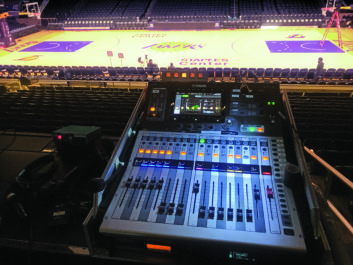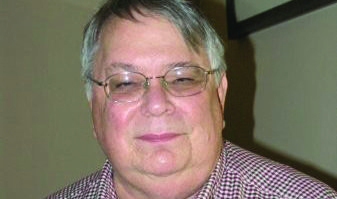 LOS ANGELES — An eight-foot table isn’t the most elegant studio, but Mike Dooley knows how to get a lot out of a little — in terms of his workspace and his audio equipment.
LOS ANGELES — An eight-foot table isn’t the most elegant studio, but Mike Dooley knows how to get a lot out of a little — in terms of his workspace and his audio equipment.
Dooley is the lead engineer for the NBA’s Los Angeles Lakers’ home radio broadcasts, covering more than 40 regular and preseason games, and possibly post-season. For each game, he shares that table in the Staples Center with five audio positions for hosts and guests. To make his broadcast set-up easier, faster and more compact, Dooley uses the Yamaha TF1 digital mixing console.
“A challenging element of sports broadcasts, especially basketball where you’re always on-site in the arena, is space is extremely limited,” Dooley said. “The less space I take up, without sacrificing any audio quality, means there’s more space for the other guys to prepare notes and conduct interviews.”
FOOTPRINT
The compact and portable TF1 gives Dooley that balance of performance and footprint. The Lakers’ home radio broadcasts, including pre- and post-game shows, originate onsite in the arena and air on KSPN(AM) 710 ESPN in Los Angeles and on the Lakers’ broadcast network of 11 radio stations from New Mexico to Hawaii.
“Throughout each game broadcast, I’m responsible for play-by-play, color commentator, producer, stats and guests, so I need to be ready for anything. Plus, I have to manage wireless and have compression limiter control, along with the mixing.”
Dooley started using the Yamaha TF1 console in January and has since cut his preproduction time in half while streamlining his audio workflow. The TFI console’s multiple aux outputs give him enough flexibility for each broadcast.
“I have five announcer positions that like personalized mixes and the analog board I was using had run out of room,” Dooley said. “With the TF1, I can customize mixes, giving each person their own mix and levels. Being able to EQ everything separately with total control over compression on every channel and outputs and inputs has been wonderful.”
He continued, “I’ve been a Yamaha user for more than a decade on other projects, and I recently converted my audio infrastructure to newer Yamaha products, including CL3 and CL5 series mixers. The Dante connectivity between each makes set-up and operation simple. Now everything is in the Yamaha world, familiar, easy to use and with the expandability needed.”
[Read “How to Choose Your Next Radio Console”]
He added that the console’s Dante interface lets him connect to the announcer boxes using a single CAT-5 cable to each, another factor contributing to reduced set-up time. “The sound is superb without having to use the standard microphone cable involved with an analog board.”
Dooley also takes advantage of the Dugan Automixer for his announcer’s microphone channels.
“Our broadcast position is right in the middle of the crowd, about 15 rows up from the floor. The Dugan software that shipped with Firmware Update 3.5 for the TF1 console is extremely helpful in keeping the crowd noise bleeding in the microphones down to a minimum, allowing me to add what I need via crowd mics instead of fighting with it during the play-by-play. It also helps make our post-game interviews with players on the court sound fantastic.”
The mixer’s all-in-one design makes transporting his equipment easier.
“I previously had an outboard compression limiter that was heavy and took up a lot of space,” he said. “The TF1 console’s onboard compression was appealing, packing all the functions I need into one unit and letting me do more than I could before, easily and with higher quality results.”
For information, contact John Schauer at Yamaha Corp. of America in California at 1-714-522-9011 or visit https://usa.yamaha.com.







